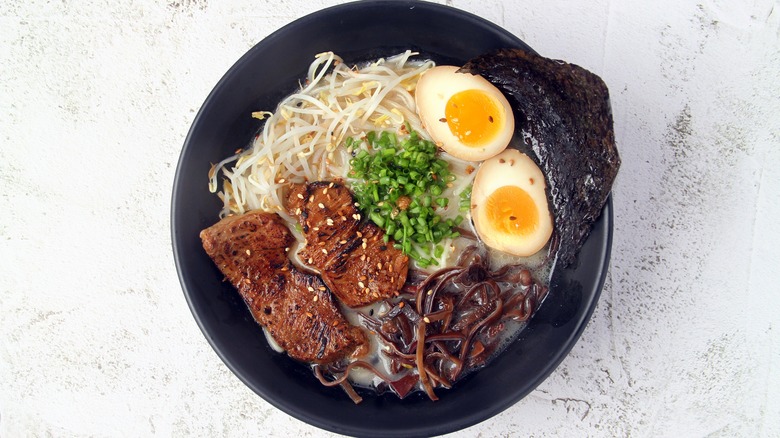The Japanese Tourist Train That's Fueled By Ramen
The London buses running on coffee have met their match. All aboard the Japanese tourist train fueled by ramen! How exactly does such biofuel work, though?
There are two main types of biofuel, according to the U.S. Department of Energy. The first, ethanol, is an alcoholic binding agent made from plant material such as corn starch or sugar. Mixing that concoction with gasoline decreases smog emissions yet increases octane, and so, nearly 100% of all U.S. gas contains at least some ethanol. The second, biodiesel, is a nontoxic and biodegradable liquid fuel derived from animal fat, cooking grease, or vegetable oil.
Apparently, ramen is one potential source of such biofuel. The dish, as noted by Encyclopedia Britannica, is a noodle soup that originated in Chinese cuisine and then made its way over to Japan, where it became a fast food staple. There are many styles of ramen, but it's typically served hot with broth, egg noodles, protein, and veggies. Thanks to globalization and the invention of convenient products like Cup Noodles, ramen has become a worldwide phenomenon. Now, it's even made its way into the fuel tanks of locomotives!
Discarded ramen goes full steam ahead
That's right, ramen has gone from "chew chew" to "choo choo!" In 2022, as reported by the Mainichi, a sightseeing train operated by Amaterasu Railway Company switched over to biodiesel fuel that's made from leftover ramen. The soup is collected from restaurants in and around the town of Takachiho, in Japan's Miyazaki Prefecture, then leftover tempura cooking oil and lard extracted from pork bone broth are both used to create the fuel. Environmentally friendly, the mixture costs almost the same as diesel does and works just as well, yet it doesn't produce black smoke or exhaust fumes. Instead, it fills the air with the scent of stir-fried food.
Fumihiko Takayama, president of the Takachiho Amaterasu Railway Company, has worked for over a decade now to revitalize their local, previously discontinued railway. Initially, it was slow-going, with wooden trolleys being manually pushed across the track. Slowly but surely, though, they upgraded, eventually allowing tourists to ride modified trucks to the tallest railway bridge in Japan. More recently, their train became a towing tractor with a glass floor that let passengers appreciate the nearby canyon and forest as well as the lit-up tunnels the vehicle passed through. Now, their train is filled with ramen, and Takayama writes, "My heart is filled with the feeling that I am glad I did not give up."
Japan lays tracks for a sustainable future
Transforming leftover ramen into biofuel is a good way to counteract food waste, and this appears to be part of a wider trend. According to the Government of Japan, food loss is a global problem, so around the turn of the millennium, the island nation decided to cut its food waste in half by the time 2030 rolls around. A lot of that effort boils down to how Japanese households manage their food supplies, but even more of it falls upon the shoulders of Japanese industry.
The Takachiho Amaterasu Railway Company is indeed part of this campaign, as documented by the Washington Post since environmental issues were on the agenda for the business from the beginning. "We wanted it to be something more than just a tourist attraction," explained Amaterasu general manager Hiroyoshi Saitoh. "We wanted people to become more conscious about environmental issues as well as biodiesel." Fortunately, the railway company isn't alone. Other Japanese businesses are accomplishing similar things, such as Fabula, which uses food scraps to create concrete, and NOD, which uses coffee grounds and eggshells to 3D-print furniture. Now, Japan can confidently work up an appetite for a greener future ahead.


